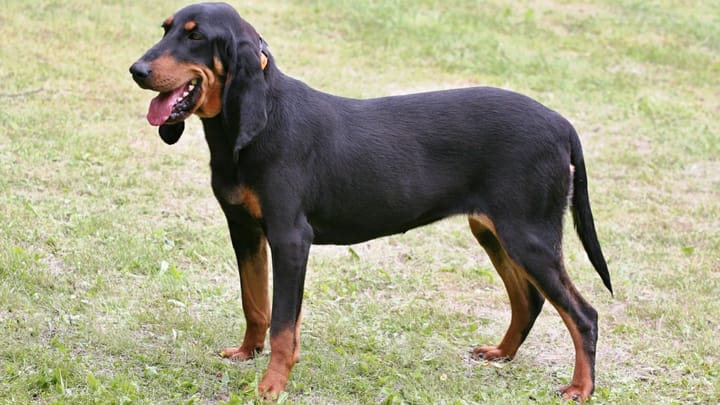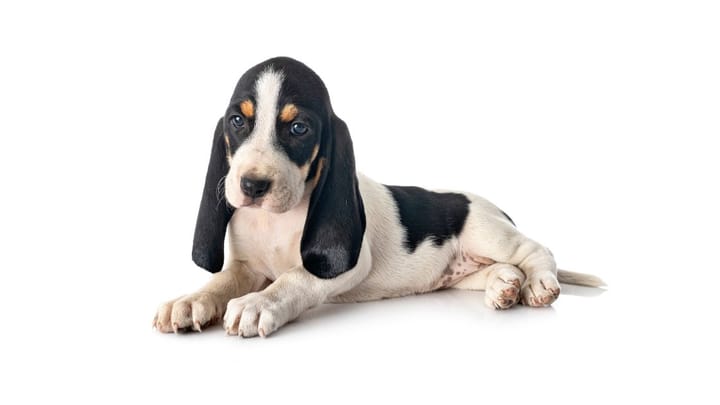Swiss Hound
Other names : Swiss Scent hound, Berner Laufhund, Bernese Hound, Jura Hound, Bruno Jura Laufhund, Lucerne Hound, Lucerner Laufhund, Schwyz Laufhund, Schweizer Laufhund


The Schweizer Laufhund is certainly one of the best hunting dogs in the world. He looks very much like the Bloodhound. While he is a working dog, he’s very rarely kept as a family pet. This dog is a medium-sized hound, with a long body, drooping ears and short fur. There are actually 4 varieties of the Schweizer Laufhund and they are all very similar, other than their hair type. They are the Lucerne Hound, Schwyz Hound, Jura Hound and the Bernese Hound.
|
Life expectancy |
The Swiss Hound has a life expectancy of between 12 and 14 years |
|
Temperament |
|
|
Size |
Medium
|
|
Adult size |
Female
Between 19 and 22 in
Male
Between 19 and 23 in
|
|
Adult weight |
Female
Between 33 and 55 lb
Male
Between 33 and 55 lb
|
|
Coat colour
The Jura Hound: Black and Tan (Grey and white markings allowed) |
Black White Brown Blue Red |
|
Type of coat
All the dogs that come under this breed have short, smooth and harsh hair. |
Short |
|
Eye colour
Light or dark brown. |
Brown
|
There are four varieties of hounds that fall under the banner of Schweizer Laufhund, but for registration purposes, they are all grouped under the same name. The Bernese Hound, Jura Hound, Schwyz Hound and the Lucerne Hound are all very similar apart from their different coat colours. The Thurgovia Hound is also a variation which is now thought to be extinct.
More details about the Swiss Hound
Swiss Hound: Origins and history
The Schweizer Laufhund is an ancient breed, native to Switzerland. It is thought to have been developed from Roman hounds, although it wasn’t really popular until the Middle Ages. At this time, these dogs were favoured by European nobility. The Schweizer Laufhund received pedigree status in 1880 and then followed FCI recognition in 1933.
Physical characteristics of the Swiss Hound
All four of these Schweizer Laufhund dog varieties look extremely similar, apart from their distinctive coat colours. Each of the dog groups also appear in both Standard and Small sizes. These dogs have athletic and muscular bodies and their body shape is longer than it is tall. The dog’s ears are expansive and droopy and his eyes very expressive and pleading. The tail should be curved, while also elegant and slim.
FCI classification of the Swiss Hound
-
Group 6 - Scent hounds and related breeds
-
Section 1 : Scent hounds
Swiss Hound: Varieties
- Bernese Hound
- Jura Hound
- Lucerne Hound
- Schwyz
Swiss Hound: Characteristics
Swiss Hound: Behaviour
Training a Swiss Hound
Although this dog isn’t headstrong, he does need an experienced trainer who can show the dog who is in charge. The Jura Hound has no problems learning how to hunt, this comes very naturally to him.
Swiss Hound: Lifestyle
Breed compatibility Swiss Hound
Swiss Hound: Purchase price
Currently in the UK, there are no documented costs to purchase a Jura Hound. Average monthly costs to keep one of these dogs in the home will be around £100 to £120 which will cover feed, vet’s bills, and pet insurance.
Swiss Hound: Grooming
The dogs in this Schweizer Laufhund group all have short hair and a low maintenance coat. There is no need for a professional trim, and a weekly brushing should suffice to remove grime and dead fur.
Swiss Hound: Health
As far as the health of the Schweizer Laufhund goes, he is relatively healthy. The average life expectancy for this breed is 12 to 14 years.
The stamina of this dog is notable; he has enormous strength and endurance when hunting.
With his short coat hair, this dog won’t have many issues in periods of hot weather. Shade needs to be provided from the midday sun if he is kept outside.
These dogs are bred to follow quarry in the mountainous regions of Switzerland, regardless of how cold the climate is.
While the Jura Hound is a working dog, he won’t tend to gain weight easily. However, once he retires from the working dog life and his lifestyle becomes more sedentary, he can be more prone to becoming obese.
- Hip dysplasia
- Elbow dysplasia
- Entropion
- Ectropion
- Cataracts
- Progressive Retinal Atrophy/PRA
- Luxating Patella/Patellar Luxation
- Demodicosis/Demodectic Mange/Demodex Mange
- Ear infections



